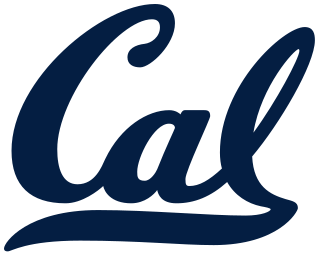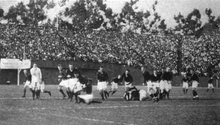
College football is gridiron football that is played by teams of amateur student-athletes at universities and colleges. It was through collegiate competition that gridiron football first gained popularity in the United States.

The Big Game is the name given to the California–Stanford football rivalry. It is an American college football rivalry game played by the California Golden Bears football team of the University of California, Berkeley, and the Stanford Cardinal football team of Stanford University. Both institutions are located in the San Francisco Bay Area. First played in 1892, it remains one of the oldest college rivalries in the United States. The game is usually played in late November or early December and its location alternates between the two universities every year. In even-numbered years, the game is played in Berkeley while odd-numbered years are played at Stanford.
The history of American football can be traced to early versions of rugby football and association football. Both games have their origin in multiple varieties of football played in the United Kingdom in the mid-19th century, in which a football is kicked at a goal or kicked over a line, which in turn were based on the varieties of English public school football games descending from medieval ball games.

Glenn Scobey Warner, most commonly known as Pop Warner, was an American college football coach at various institutions who is responsible for several key aspects of the modern game. Included among his innovations are the single and double wing formations, the three point stance and the body blocking technique. Fellow pioneer coach Amos Alonzo Stagg called Warner "one of the excellent creators". He was inducted as a coach into the College Football Hall of Fame as part of its inaugural class in 1951. He also contributed to a junior football program which became known as Pop Warner Little Scholars, a popular youth American football organization.

The California Golden Bears are the athletic teams that represent the University of California, Berkeley. Referred to in athletic competition as California or Cal, the university fields 30 varsity athletic programs and various club teams in the National Collegiate Athletic Association (NCAA)'s Division I primarily as a member of the Atlantic Coast Conference (ACC), and for a limited number of sports as a member of the Mountain Pacific Sports Federation (MPSF). In 2014, Cal instituted a strict academic standard for an athlete's admission to the university. By the 2017 academic year 80 percent of incoming student athletes were required to comply with the University of California general student requirement of having a 3.0 or higher high school grade point average.

Leonard Joseph Casanova was an American football and baseball player, coach, and college athletics administrator. He served as the head football coach at Santa Clara University (1946–1949), the University of Pittsburgh (1950), and the University of Oregon (1951–1966), compiling a career college football record of 104–94–11. Casanova was also the head baseball coach at Santa Clara from 1940 to 1942, tallying a mark of 39–25. After retiring from coaching, he served as the athletic director at Oregon. Casanova was inducted into the College Football Hall of Fame as a coach in 1977.
The California Golden Bears football program represents the University of California, Berkeley in college football as a member of the Atlantic Coast Conference at the NCAA Division I FBS level. They were previously a member of the Pac-12 Conference. The team plays its home games at California Memorial Stadium and is coached by Justin Wilcox. Since beginning of play in 1886, the team has won five NCAA recognized national titles - 1920, 1921, 1922, 1923, 1937 and 14 conference championships, the last one in 2006. It has also produced what are considered to be two of the oddest and most memorable plays in college football: Roy "Wrong Way" Riegels' fumble recovery at the 1929 Rose Bowl and The Play kickoff return in the 1982 Big Game.

The Stanford Cardinal football program represents Stanford University in college football at the NCAA Division I FBS level and is a member of the Atlantic Coast Conference. The program was previously in the Pac-12 Conference. The team is known as the Cardinal, adopted prior to the 1982 season. Stanford was known as the "Cardinal" for its first two decades of athletic competition, then more commonly as the "Cardinals" until 1930. The name was changed to the "Indians" from 1930 to January 1972, and back to the "Cardinals" from 1972 through 1981. A student vote in December 1975 to change the nickname to "Robber Barons" was not approved by administrators.
The Santa Clara Broncos are athletic teams that represent Santa Clara University. The school colors are red and white. The nicknames for teams is The Broncos and the student fans are referred to as the "Ruff Riders". The Broncos compete in the NCAA Division I (NCAA) as members of the West Coast Conference of which Santa Clara is a charter member.

James Francis Lanagan was an American football, rugby, and baseball coach at Stanford University.
The 1905 Stanford football team represented Stanford University in the 1905 college football season. In head coach James F. Lanagan's third season, Stanford went undefeated. The team played their home games at Stanford Field in Stanford, California.

The United States Coast Guard Academy's intercollegiate sports teams are called the Bears. They compete in NCAA Division III as members of the New England Women's and Men's Athletic Conference. Through the 2016 season, the Bears played football in the New England Football Conference, but after that season moved their football program into the NEWMAC, which started sponsoring the sport in 2017.
The 1904 Stanford football team represented Stanford University in the 1904 college football season. James F. Lanagan was in his second year as head coach of the team, which played its home games at Stanford Field in Stanford, California.

The California Golden Bears rugby team is the college rugby team of the University of California, Berkeley. The Golden Bears have won 33 championships since the national collegiate championships for rugby began in 1980. Current head coach and Cal alumnus Jack Clark took over the team in 1984, and has achieved prolonged success, leading the Bears to 28 national titles, including twelve consecutive championships from 1991 to 2002, five more consecutive titles from 2004 to 2008, and back-to-back titles in 2010 to 2011 and 2016 to 2017.
The 1924 Stanford football team represented Stanford University as a member of the Pacific Coast Conference (PCC) during 1924 college football season. Led by first-year head coach was Pop Warner, Stanford compiled an overall record of 7–1–1 with a mark of 3–0–1 in conference play, winning the program's first PCC title as co-champions with California. Stanford made its second bowl game appearance, losing to Notre Dame in the Rose Bowl.
The 1919 Stanford football team represented Stanford University in the 1919 college football season.

The early history of American football can be traced to early versions of rugby football and association football. Both games have their origin in varieties of football played in Britain in the mid–19th century, in which a football is kicked at a goal or run over a line, which in turn were based on the varieties of English public school football games.

The first recorded match between two colleges in game played in United States using rugby union code rules occurred on May 14, 1874 between Harvard University and McGill University. Predating rugby using the rugby union rules were rugby union style "carrying games" with use of hands permitted including a game between Harvard College Freshmen and Sophomores at a game played at Harvard campus in 1858. Harvard varsity interscholastic rugby team was not founded until December 6, 1872
The history of California Golden Bears football began in 1886, the team has won five NCAA recognized national titles - 1920, 1921, 1922, 1923, and 1937 and 15 conference championships, the last one in 2006.











